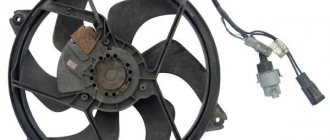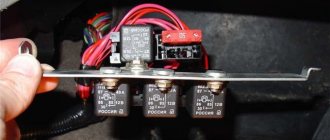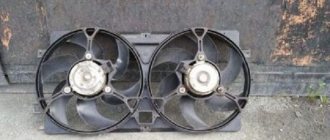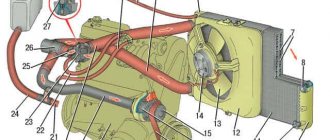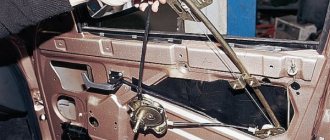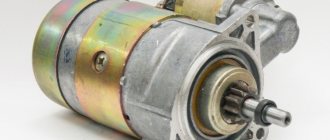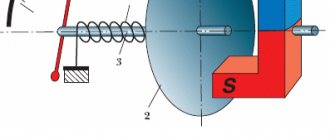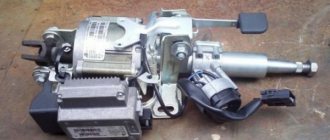There are many important components in a car, and the quality of the car as a whole depends on how well they work. One of these is the cooling system. It often happens on some models that the cooling fan is constantly running. This is not a very good sign. Insufficient engine cooling can lead to overheating of the engine - and this, in turn, can cost the owner a large sum of money for major repairs. But if you know the reasons for such operation in the cooling system, you can quickly identify where the fault is hidden and eliminate it. In order to find a breakdown, you do not need special knowledge and skills. Even a beginner can handle this. There are not many reasons why the cooling fan is constantly running.
The principle of operation of a fan in a cooling system
One of the reasons why a fan may run constantly or turn on frequently is due to the way the system operates. The fan starts at the command of a special sensor. It is located on the bottom of the radiator. This sensor is responsible for the coolant temperature indicators. If it is larger than needed, then the radiator fan will start.
When its blades rotate, additional airflow is created. It helps reduce the temperature of the coolant, which then passes through the passages in the engine. The cooling fan constantly works only on motors that for some reason overheat. To avoid serious problems, it is necessary to respond to this problem immediately.
DTOZH
The radiator fan of the VAZ 2114 may not turn off due to a malfunction of the coolant temperature sensor. This device transmits information about the antifreeze temperature to the ECU. If it exceeds 101 degrees, the fan turns on to cool it down. If the DTOZh breaks down, the electronics receive an incorrect signal. Therefore, the element can operate continuously. The sensor is installed in the cylinder head on the intake manifold.
It is not necessary to call the DTOZH to check. You can borrow a known-good part for a while and evaluate the operation of the system. If everything works as expected, the sensor should be replaced. Sometimes damage to an element can be noticed visually.
When checking this part, it would be useful to inspect the wires and their connections. Sometimes the cause of the malfunction lies in poor contact or broken wiring. In this case, the connections are cleaned of contaminants and the integrity of the wires is restored.
Thermostat
The engine may overheat due to the thermostat. It often happens that the mechanism of this element jams. The fan, in turn, necessarily reacts to this. The thermostat itself remains only half open.
As a result, the coolant cannot effectively remove heat from the engine as its movement through the system slows down. When the power unit overheats and the coolant temperature rises, the sensor reacts to this event and starts the fan. Owners of Opel Astra cars often encounter this problem - the cooling fan is constantly running. And the problem is solved by replacing the thermostat.
Forced fan activation
If the VAZ 2107 fan sensor is broken, it is quite possible to drive on a good road without noticing it. But as soon as you drive onto a country road or get into city traffic jams, the engine will start to overheat. Replacing the fan sensor is not very difficult, but requires draining the coolant. Even if you have a spare sensor at hand, replacing it on the road is problematic. There is an easier way out of the situation.
The following operations must be performed:
- disconnect “mass”;
- remove two wires from the sensor terminals and connect (“short-circuit”) them;
- insulate the exposed contacts of the connected wires;
- connect ground.
In this case, the fan will run continuously. To turn it off, you will have to disconnect the ground and disconnect the contacts.
If you have already experienced problems with the fan sensor on the road, you can install a forced fan circuit on the car that operates in parallel with the sensor. To do this, just connect a couple of wires to the terminals going to the sensor contacts and stretch them into the engine compartment. Install a separate button (toggle switch) on the dashboard and connect the wires to it so that you can close them if necessary.
In this case, if the sensor malfunctions, there will be no need to crawl under the hood to force the fan to start.
How to check the cooling system thermostat
Testing it is quite simple. To do this, you need to start the engine and warm it up to such temperatures when the valves of this mechanism operate. You can find out the temperature threshold directly on the device body. Usually it is 72 or 80 degrees. Then you need to check the temperature at the lower and upper pipes. If both are at approximately the same temperature, then the reason why the cooling fan is constantly running has been found. It is recommended to carefully inspect the thermostat valves after removing it. It is useless to repair this unit (it is easier and cheaper to buy a new one). By the way, if this element is dismantled, it can be checked without installing it in the car. To do this, the thermostat is placed in a container of water, which is then heated. Increasingly, the valve should open. If this does not happen, the device is faulty.
Cooling pump
Sometimes the reason why the cooling fan keeps running and won't turn off is the water pump. The temperature of the coolant in the radiator rises because its speed is slowed down. When liquid enters the cooling radiator, the antifreeze simply does not have time to cool to the required temperatures and passes to the next round. At the same time, the liquid heats up even more.
When the pump works somehow, the fan may indicate a problem. If the pump completely breaks down, then the engine will immediately boil - this is where serious problems and expensive repairs usually begin.
Let's consider them in order.
Closure
The first and most common reason for such a malfunction is a short circuit (and most often, fusion) of the wires going to the fan. As a result of this short circuit, the electrical circuit turns on, regardless of the operation of the temperature sensor and relay. It is very simple to identify such a malfunction - just ring all the wires and check whether they are shorted (in some cases, the fact of fusion of wires can be detected even visually during inspection).
Fusion of two wires
If the “diagnosis” does not produce results, then the search for the cause should be continued, namely, checking the fan relay. The easiest way to do this is to dismantle the relay and install a new one of a similar model in its place.
Although the price of this device is low, you can do without purchasing a new relay at all. It’s enough just to borrow it for a couple of hours from a motorist friend who owns a VAZ 2114, and after checking it, return it back.
If after replacement the fan begins to operate normally, it means that the old relay was indeed damaged, and you will still have to buy and install a new one. If not, then you should move on to checking the temperature sensor.
Thermal sensor
Thermal sensor (also known as coolant temperature sensor, also known as DTOZH) is a device that reports the coolant temperature to the electronic system. As already mentioned, it is this that causes the fan to start and turn off depending on the temperature of the radiator. It is not surprising that a broken temperature sensor is a common reason why the VAZ 2114 cooling fan does not turn off.
Coolant temperature sensor
In this case, the system “thinks” that the liquid temperature is constantly high and does not drop (after all, the sensor is stuck at maximum), so no command is received to turn off the fan. To solve this problem, you will also have to purchase a new sensor and install it in place of the old one. If the fan starts working properly, then the sensor was the cause. If not, then the last possible malfunction remains - the electronic control unit.
Speaking about the temperature sensor going off scale, it is worth noting one very important point. If the cooling fan runs constantly, but the temperature on the dashboard is displayed correctly, then you can continue driving the car. If the fan does not turn off, and the instrument in the cabin shows boiling coolant, then trips should be stopped immediately and a full diagnosis of the cooling system should be carried out. This will help prevent engine overheating and failure.
Electronic module
As already mentioned, if all other elements of the electrical circuit are working properly, but the VAZ 2114 fan still does not turn off, all that remains is to check the last important link - the electronic module. It is worth noting that it rarely fails, but sometimes it does happen.
In this case, a solution to such a problem could be either a complete reset of all errors in the block or its flashing. Since it is quite difficult to do this at home, the best option would be to contact a car service.
ECU VAZ 2114
Pump faults
Often, the pump does not stop working suddenly. Initially, the pump gives various signals about breakdowns - for example, the engine cooling fan is constantly running or turns on frequently.
The main reason for pump failure is the bearing - it jams or collapses. You can tell that the pump has failed by the characteristic sounds coming from under the hood. They sound like some kind of howling or knocking. These sounds can be heard even at idle. Novice motorists often do not pay attention to these noises. Pump knocks are mistaken for camshaft malfunctions. To fix the problem, you need to replace the pump. Depending on the model, it is possible to install only the front part of the pump and replace the bearing.
content .. 22 23 24 25 ..Lada VAZ-2110 (2111, 2112). The engine cooling fan runs constantly (even at idle)
| Restore contact in electrical circuits. Replace the faulty sensor | ||
| Fan relay contacts do not open | Checking with a tester | Replace the faulty relay |
| The ECU or its circuits are faulty | Check the ECU or replace with a known good one | Replace the faulty ECU |
The cooling fan turns on on a cold engine: the main reasons and solution to the problem
As you know, various malfunctions of the engine cooling system do not allow the engine to reach the optimal temperature regime. The engine may overheat, which can lead to rapid breakdown, or remain cold, that is, not reach operating temperature.
Modern cars use a combined internal combustion engine cooling system: liquid and air cooling. By liquid we mean the circulation of antifreeze or antifreeze through special channels in the cylinder block and cylinder head of the engine.
The coolant circulates thanks to a pump. For additional cooling, the coolant can also circulate in a small circle (inside the engine) and in a large circle, that is, through the radiator.
Air cooling is implemented using a fan, which removes excess heat by supplying an air flow into the engine compartment to blow over the engine. The specified fan is activated when the heating of the unit is sufficiently high. However, quite often drivers are faced with the question of why the cooling fan turns on on a cold engine, the engine fan turns on in winter or spins constantly. In this article we will talk about the reasons why the cooling fan operates on a cold engine, the engine cooling fan does not turn off, or the specified fan does not work correctly.
The fan runs on a cold motor: causes, diagnosis, repair
Let's start with the fact that this problem can clearly indicate both a malfunction of the liquid cooling system and a malfunction of the fan itself. In any case, we are talking about a breakdown that cannot be ignored, since the risk of overheating of the internal combustion engine significantly increases.
For a better understanding, it is necessary to superficially consider the principle of operation of the fan on most modern cars. The airflow is activated by a special sensor located at the bottom of the radiator. Also, many cars use a separate engine cooling fan control unit. There are also models in which the ECU itself is responsible for turning on the fan, but this design is rarely used.
So, after heating the coolant to an average temperature of about 100 degrees Celsius, the sensor or control unit closes the electrical circuit. After this, the fan turns on, improving engine cooling. When the coolant temperature drops to the required value, the circuit opens and the blowing stops. As you can see, the fan should not work on a cold engine. So, to determine why the fan turns on early, for injection cars with an OBD II diagnostic connector, it is recommended to start with computer diagnostics of the car. The fact is that the ability to read error codes from the ECU allows you to more accurately determine the cause of the malfunction.
We also note that in cases where the control unit detects errors in the cooling system, the fan can spin immediately after turning on the ignition, even on a cold internal combustion engine. This feature is found only on some models and is, in fact, protection against overheating of the power unit, since a constantly running fan reduces the temperature.
After repair, in this case you will also need to reset the errors. To erase an error from the ECU, on some models it is enough to remove the terminal from the battery for a couple of minutes, while on others the reset is carried out using diagnostic equipment.
Common cooling fan problems
Now let's look at common problems that are associated with the cooling system and the fan itself.
First of all, in many cases the contacts of the air system sensor short-circuit. In this case, the air blower is activated immediately after the ignition is turned on. During the diagnostic process, the resistance at the outputs is measured on a cold sensor using a multimeter. Deviations from the norm will indicate the need to replace the element.
There is not enough coolant in the liquid system. In this case, the fan is triggered due to the fact that a small amount of antifreeze or antifreeze heats up very quickly. In other words, the fan is working properly and starts naturally. As a rule, leaks or decreased coolant levels in the expansion tank are the main cause. Please note that antifreeze is a mixture of concentrate and water. Water gradually evaporates from the system, causing the level to drop. For this reason, it is recommended to periodically check and add fluid according to special marks.
If there is little coolant in the system, heating occurs quickly. It is also noteworthy that the actual temperature of the liquid is very different from the temperature of the internal combustion engine. It often happens that a cold engine is started, the temperature arrow on the dashboard has not yet risen, but the fan is already working because the liquid is too hot. To solve the problem, it will be enough to fill in antifreeze and remove air plugs from the cooling system. The fan shorts to ground because the wire may not be screwed securely enough, the contact point has been damaged, etc. In this case, the fan can short-circuit to the battery and run non-stop. In such a situation, you need to check all contacts, wiring and other elements. Wires must be securely insulated and properly connected.
The fan sensor, which is integrated into the thermostat housing, has failed. Quite a lot of modern cars are designed with a thermostat, which is combined with a fan control sensor. This solution allows for flexible control of the engine cooling system. However, if there is a problem with the temperature sensor in the thermostat housing, the fan may start running without turning off. The fact is that the control unit begins to receive incorrect signals about how the thermostat works. As a result, the emergency mode is activated, the fan turns on and runs continuously.
In such a situation, you need to check the sensor with a multimeter. Normally, on a cold engine its resistance is infinite, in other cases the indicator should be 100 - 500 Ohms. Deviations in the readings from the norm will indicate that the sensor needs to be replaced with a new one or a known good one.
The outside air temperature sensor has failed. This problem occurs on some cars that are equipped with ambient temperature sensors. If the temperature is above the permissible limit, then these sensors will turn on the fan. This solution allows for more efficient cooling of the power unit, especially on cars that have a powerful forced-internal combustion engine and several radiators. On such units, the fan can be turned on in the warm season even on a cold internal combustion engine to protect against engine overheating.
After turning on the car air conditioner, the fan is constantly running. Note that on some models this fan operation is normal. If we talk about malfunctions, on most modern cars the cooling system is closely connected with the air conditioning system. It is for this reason that contamination of the air conditioner radiator can cause the engine cooling fan to constantly operate at maximum speed. To solve the problem, external cleaning of the air conditioner radiator and cooling system radiator may be required. The fact is that these radiators are located next to each other, dirt, dust and fluff accumulate between them. Removing such a “coat” allows you to normalize the operation of the air conditioning and engine cooling system, get rid of frequent fan starts and increased noise during its operation.
Problems with wiring and electrical contacts. Regardless of how the fan is controlled, contacts are a common cause of problems. Oxidation of contacts or damage to wiring, insufficient fixation at connections and other defects lead to short circuits, transmission of incorrect signals to control units, etc. As a result, the overheating protection mode is activated by constantly rotating the fan, etc. In order to avoid such a situation, experienced drivers recommend cleaning contacts before the onset of winter and summer for preventive purposes. Treatment with special lubricants and protective compounds is also actively practiced.
Bottom line
As you can see, the internal combustion engine itself and its systems require regular maintenance. As for the cooling system, it is also no exception and requires special attention.
Overheating of the engine, steam from the radiator pipes. We also recommend reading the article about what are the most common malfunctions characteristic of the car engine cooling system. From this article you will learn about the main reasons for incorrect operation and possible breakdowns of this system. If the driver notices that the cooling fan has started to work at maximum speed all the time or has stopped turning off in a timely manner, then the first thing you should do is check the antifreeze level, the functionality of the pump and thermostat.
It is also necessary to take into account that the reason for such fan operation may be a clogged cooling radiator or too high outside air temperature, shorted contacts, etc. We should not forget that the fan can constantly spin on a cold engine when the air conditioner is running.
content .. 22 23 24 25 ..
Clogged cooling system channels
Often the engine overheats due to congestion in the cooling system. The situation is further complicated by the fact that diagnosing this problem can be quite difficult. Therefore, if the cooling fan constantly works or turns on more often than usual, it would not be superfluous to flush the SOD channels. In most cases, these activities are more than enough to ensure everything works correctly. Experts also recommend not limiting yourself to just flushing, but also additionally venting the radiator.
How to clean the cooling system
When cleaning the channels of the cooling system and radiator, the antifreeze is also replaced. To perform flushing, the old antifreeze must be drained. Then a fairly strong solution based on citric acid is poured into the system. This is an effective folk remedy, but there are also various liquids with additives.
After this, start the engine - so the car should run for 30 minutes. This is enough to thoroughly clean all channels. Then you can turn off the engine, drain the cleaning mixture, and finally add fresh antifreeze. Often in this way it is possible to completely solve problems in the operation of the cooling system if the reasons are contamination.
VAZ 2107 fan sensor malfunctions and performance check
It is easy to find out whether the VAZ 2107 fan switch sensor is working properly. The fan motor is quite noisy; you can hear it turning on even from inside the cabin. If the temperature gauge shows more than 90 degrees, but the fan does not turn on, you should check the sensor.
First you need to localize the source of the problem. If the antifreeze is hotter than 90 degrees, but the bottom of the radiator remains cold, the problem is the thermostat, not the fan. It is not possible to replace the thermostat on the road. To get out of the situation, you can increase the cooling by fully opening the heater damper and turning on its fan. Of course, such a solution will be extremely uncomfortable in the warm season, but, if you’re lucky, it will make it possible to get to the repair site without stopping. If this is not enough, you will have to make stops along the way to allow the engine to cool.
Another reason for overheating is low coolant level. In this case, it is necessary to quickly find and eliminate the leak and add antifreeze to the system. If it is not there, you can add water to the system. But then, as soon as possible, it is necessary to drain the liquid from the cooling system and add antifreeze.
If the radiator is hot and the fan does not start, you need to try to start the fan by short-circuiting the two wires going to the sensor contacts. If the cause of the breakdown is the latter, the fan should start working.
If the sensor is not installed on the car, you can check it using a thermometer and ohmmeter. You need to place the part of the sensor that is inserted into the radiator into water and heat it to about 90 degrees. The sensor should turn on when the water heats up to no more than 92 degrees. The switching on (closure of the sensor contacts) is indicated by the absence of resistance between the sensor terminals.
How to flush a radiator
To correct the situation and protect the motor from harmful overheating, it is recommended to clean the element. On most modern cars, the part must first be dismantled, but cleaning can often be done without dismantling.
Experts recommend cleaning with ordinary water. It is best if it is supplied through a hose. Sometimes it makes sense to clean the radiator cells with a brush and only then flush them. Often this procedure is combined with blowing the radiator with compressed air.
Air locks in the cooling system
For experienced car owners, air locks are not a secret at all. They arise due to some errors during the process of replacing the coolant. Leaks in the system are also the cause. Antifreeze cannot warm up evenly. This leads to instability in the fan operation. It often turns on or even works without interruption - hot coolant enters the radiator. Before you try to eliminate these same traffic jams, you need to check the system for leaks. If they are found, then they should be eliminated. Next you need to remove the plugs. For this you need a compressor. One tube is unscrewed from the throttle, which supplies fluid. Then a compressor is connected to the neck of the expansion tank and the air supply begins. Two to three minutes will be enough for all traffic jams to go away.
Problems with the temperature sensor
If the cooling fan on a VAZ 2107 is constantly running, then the radiator temperature sensor on both carburetor and injection cars is often to blame. In most cases, it is simply in a closed state.
If these are the symptoms, then check the time for which the fan turns on and compare the temperature when it turns on with the standard one. If the indicators are lower, then the problem is easily solved by replacing the sensor.
The radiator fan is constantly running on a carburetor VAZ 21093
Let's consider the causes of the malfunction: “the radiator fan of the car engine cooling system is constantly running.”
Using the example of the cooling system of a carburetor (21083) engine of a VAZ 21093 (21083, 21099).
Symptoms of a problem
The radiator fan starts working immediately after turning the key in the ignition, despite the fact that the engine has not yet warmed up.
The radiator fan stopped turning off after being turned on normally when the engine was warm.
Causes of malfunction
— The on/off sensor of the fan motor on the radiator is faulty
On-off sensor for the electric fan on the radiator of the cooling system of VAZ 2108, 2109, 21099
In the cooling system of the carburetor engine 21083 of the VAZ 21093, the on-off sensor installed in the right radiator tank is responsible for the timely turning on and off of the fan on the radiator. When the coolant temperature exceeds 99ºC, the contacts inside the sensor are connected, closing the electrical circuit (“ground”) of the fan motor on the radiator and it turns on. When the coolant temperature drops below 94ºC, the contacts inside the sensor open, the circuit breaks, and the fan stops.
If the sensor is faulty and the contacts inside it are “stuck together” (permanently closed), then “minus” is constantly supplied to the electric motor and it starts working even when the engine is not warmed up. Or, a problem periodically arises when the fan does not turn off after cooling the coolant.
— The electrical circuit of the fan on/off sensor is faulty
On VAZ 21083, 21093, 21099 cars up to 1998. with mounting block 17.3722 (finger type fuses), in the electrical circuit of the fan motor on the radiator there was a relay installed in the mounting block. Its malfunction (a “plus” is constantly supplied to the fan motor) also leads to continuous operation of the fan.
Relay K9 of the mounting block 17.3722 is responsible for turning on the fan electric motor on the radiator of the engine cooling system of VAZ 21083, 21093, 21099 cars up to 1998.
On VAZ 21083, 21093, 21099 after 1998 (mounting block 2114) there is no relay and electric current (+) is constantly supplied to the fan motor, regardless of whether the ignition is on or not. Therefore, the fact that it does not turn off and works without stopping is only to blame for the faulty on-off sensor.
Wiring diagram for the electric radiator fan VAZ 2108, 2109, 21099
What to do if the radiator fan on a carburetor VAZ 21093 is constantly running?
If a problem occurs with a constantly running fan on the radiator, it is necessary to replace the on-off sensor with a known good one or a new one. You should also check the relay (install a known good one or a new one) and the wiring of the fan motor and sensor for a short to ground.
Notes and additions
If you continue to drive a car with a constantly running radiator fan, the coolant in the cooling system does not warm up to the required operating temperature (95ºC). This leads to increased fuel consumption and accelerated wear of engine parts. During the cold season, such operation becomes practically impossible.
Twokarburators VK - More information on the topic in our VKontakte group, on Facebook Twokarburators FS and on Odnoklassniki - Twokarburators OK
More articles on the cooling system of the carburetor engine 21083 of VAZ 21093, 21083, 21099
— Signs (symptoms) of a malfunctioning engine pump
— Engine overheats
— Checking the thermostat on VAZ 2108, 2109, 21099
— Why does antifreeze boil in the expansion tank?
— How to replace the pump VAZ 2108, 2109, 21099
— Plug of the expansion tank of the VAZ 2108, 2109, 21099 engine cooling system
— The coolant temperature indicator of VAZ 2108, 2109, 21099 does not work
Summarize
So, among the most popular reasons why a fan is unstable are problems with electronics. This is exactly what most car owners complain about on specialized forums. Many solve this problem by replacing the sensor and fuses. And it helps. In half of the cases, the issue can be resolved by replacing the thermostat. The situation can also be improved by cleaning the radiator.
Problems happen on any car; this topic worries Ford Focus car owners. The cooling fan runs constantly on luxury cars as well. It is important to notice this problem in time, otherwise it can lead to disastrous consequences. In case of severe overheating, the engine can only be helped by a major overhaul with the replacement of the cylinder head, cylinders, pistons and other components.
ECU
If the diagnosis of all other elements did not help, then the cause of the breakdown is a malfunction of the electronic control unit. But this doesn't happen often. It is not always possible to determine this malfunction on your own. Therefore, if an independent check does not give positive results, you should contact a car service center.
If the ECU fails, it is flashed to remove all existing errors or the unit is replaced. These procedures should be performed by an auto electrician. It is not advisable to do such work without experience. This device is not cheap, but, fortunately, it is replaced quite rarely. There are also several other very rare reasons why the cooling fan may not turn off. Unlike the malfunctions described above, they can usually only be identified and eliminated at a service station.
